Yeovil Trades & Traders
medical hall
Generations of chemists in the Borough
For decades the Medical Hall stood in the Borough, occupying the corner between Middle Street and Wine Street and was mostly the premises of a succession of chemists and druggists. Indeed, most large towns of this period boasted a 'Medical Hall'.
Pigot's Directory of 1824 lists druggist George Wellington as a druggist of the Borough. Wellington located in an earlier building on the site, also known as the Medical Hall, and described as a "low range of buildings". Grocer (later insurance agent and auctioneer) Henry Etheridge is known to have been in the Medical Hall from around 1824 to 1837, when he sold his grocery business and moved further along Wine Street. A lithograph of High Street made in 1839 (see Gallery) shows an entirely different building to that known from later photographs. In 1843 the Bath Chronicle referred to 'Mr George Harvey, of the Medical Hall, Yeovil'. By the time of the 1851 census the first version of the Medical Hall was occupied by 25-year old chemist and druggist John M Tytherleigh, his sister Ann, a live-in druggist's assistant and a female house servant.
By 1855 John Tytherleigh had been replaced by Thomas Charles Maggs.
The Medical Hall was rebuilt in 1860 and, in its edition of 4 December 1860, the Western Flying Post reported “One of the most striking improvements which has taken place in the shops of this town is that which is now near its completion at the Medical Hall, the establishment of Mr T C Maggs. Those who remember the low range of buildings which formerly stood there, can scarcely realise the imposing edifice which has now taken its place. The shop front from plan and designs by Mr Frederick Cox, of Middle Street, is in the Elizabethan style, having solid pilasters with sinkings and necking and frieze with sinkings and volutes with entablature and cornice to correspond." Referring to The Bow, the article continued "Our ancient friend, at the corner of Wine Street, the old patriarch of bye-gone houses, bending under the weight of timber and of years, is now more than ever out of place…”
The 1861 census noted that 35-year old London-born chemist and druggist Thomas Maggs was in residence with his wife Charlotte, their seven young children, an assistant, two apprentices, two house servants (18-year old twin sisters Eliza and Matilda Bartlett) and an errand boy. By 1871 Thomas, now aged 47, was describing himself as a pharmacist and dentist. Charlotte and seven of the children were living with him and two of the sons, 16-year old Frederick and 15-year old William, were listed in the census as chemist's assistants. There was also a pupil pharmacist, presumably an apprentice. In the 1881 census Thomas described his occupation as pharmaceutical chemist and dentist. Charlotte was still with him as well as daughter Catherine. Son Frederick was also describing his occupation as a pharmaceutical chemist and dentist. In addition there were in residence a dental assistant, a chemist's assistant, two chemist's pupils, a cook and a housemaid.
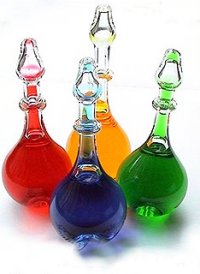 Thomas
Maggs used the
windows of the
Medical Hall to
exhibit various
fossils and
skeletons he had
collected. These
were displayed
below an array
of
brightly-coloured
chemist's jars -
the insignia of
his trade. The
Western Gazette
carried a series
of letters in
the 1930s in
which people
recalled earlier
Yeovil and one
correspondent
remembered
seeing the
skeletons of a
cat and a rat
displayed in
Maggs' window
which had been
found during the
demolition of
the "old
dressing yard
carried on in
Foot's Yard".
Apparently, it
was claimed,
that the cat had
chased a rat
deep into the
foundations but
the hole became
narrower and
narrower and
eventually both
rat and cat
died.
Thomas
Maggs used the
windows of the
Medical Hall to
exhibit various
fossils and
skeletons he had
collected. These
were displayed
below an array
of
brightly-coloured
chemist's jars -
the insignia of
his trade. The
Western Gazette
carried a series
of letters in
the 1930s in
which people
recalled earlier
Yeovil and one
correspondent
remembered
seeing the
skeletons of a
cat and a rat
displayed in
Maggs' window
which had been
found during the
demolition of
the "old
dressing yard
carried on in
Foot's Yard".
Apparently, it
was claimed,
that the cat had
chased a rat
deep into the
foundations but
the hole became
narrower and
narrower and
eventually both
rat and cat
died.
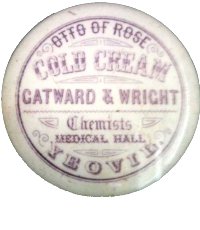 During
the late 1880s
the Medical Hall
was the premises
of wholesale and
retail chemists
Gatward &
Wright. By the time
of the 1891 census, 37-year
old
pharmaceutical
chemist
Alfred
Wright of
Hackney, London, was living
there with his
wife Jane and
unmarried business partner
Oswald
Gatward,
a chemist and
druggist. Also
in residence
were two
druggist and
chemist's
assistants, a
housekeeper and
a housemaid.
In
the 1901 census
Alfred, Jane and
partner Oswald
Gatward
were all still
in residence as
well as a
chemist's
assistant, a
cook and a
housemaid.
During
the late 1880s
the Medical Hall
was the premises
of wholesale and
retail chemists
Gatward &
Wright. By the time
of the 1891 census, 37-year
old
pharmaceutical
chemist
Alfred
Wright of
Hackney, London, was living
there with his
wife Jane and
unmarried business partner
Oswald
Gatward,
a chemist and
druggist. Also
in residence
were two
druggist and
chemist's
assistants, a
housekeeper and
a housemaid.
In
the 1901 census
Alfred, Jane and
partner Oswald
Gatward
were all still
in residence as
well as a
chemist's
assistant, a
cook and a
housemaid.
But the partnership did not survive much longer and, in 1906, it was dissolved by mutual consent.
From 1906 the Medical Hall was the premises of Tayler & Brett, as seen in the Gallery below. They specialised in photography and even offered the use of their dark room free to customers.
By 1925 the Medical Hall had become a branch of Boots the Chemist, the chain of chemist stores founded in Nottingham in 1849 by John Boot.
During the Second World War part of the Medical Hall was used as a canteen. Late in the evening of Good Friday 11 April 1941, several delay-action bombs were dropped by the Luftwaffe on the town centre with one completely destroying the old Medical Hall in the Borough. Fortunately there were no casualties as the canteen was closed at the time of the bombing. Immediately after the war the site was cleared and an ornamental garden was laid out, planted with tulips donated by Dutch children who had been evacuated to Yeovil during the Second World War.
Boots rebuilt on the site and the present building dates to 1956. Boots moved out and into new premises in Middle Street and the vacated building was then occupied by a succession of different businesses including Greenfields then Wimpy during the 1980s. Today it is occupied by Burger King.
The Signs of the Alchemical Processes (Signs of the Zodiac)
Around the building are eleven (originally twelve?) Signs of the Zodiac, or at least I always thought they were. (Many thanks to Victor Grana for pointing me in the right direction). Bearing in mind this and the previous buildings' connection with alchemy (from before 1824 until the 1970s), the use of symbols to represent alchemical processes is a far more plausible explanation than star signs.

|
The alchemical magnum opus (in alchemy, the Magnum Opus or Great Work is a term for the process of working with the prima materia to create the philosopher's stone) was sometimes expressed as a series of chemical operations. In cases where these numbered twelve, each could be assigned one of the Zodiac signs as a form of cryptography. The example at left can be found in Pernety's Dictionnaire mytho-hermétique (1758). |
The location of the signs are as follows -
Facing Middle Street - Fermentation (Capricorn), Multiplication (Aquarius), Projection (Pisces), Calcination (Aries) and Congelation (Taurus). There have always been five signs on this elevation.
Facing the Borough is Fixation (Gemini). There was only room for one symbol because of the huge clock - and when did that disappear?
In Wine Street are Solution (Cancer), Digestion (Leo), Distillation (Virgo), Sublimation (Libra) and Separation (Scorpio).
I have no idea why Ceration (Sagittarius) is missing, but it was there originally. The signs were not on Boots' previous building, the Medical Hall that was destroyed by bombing in 1941. They were not originally on Boots' new building (today's Burger King) that opened in 1956. As far as I can tell, they first appeared during the 1960s.
MAP
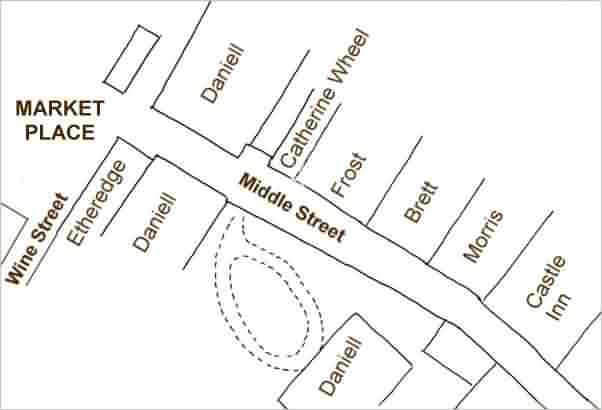
This map is based on Edward Bullock Watts' map of October 1829. Henry Etheridge's premises are noted at left, on the corner of Middle Street and Wine Street.
gallery
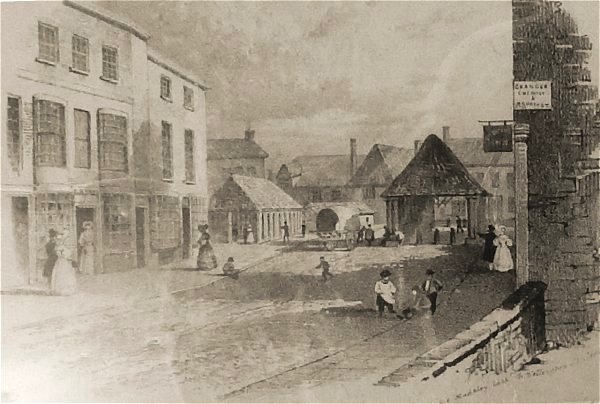
This sketch, made by GE Madeley to illustrate his map of 1831, shows the Borough seen from High Street - roughly the view seen today from the north end of King George Street. The Shambles is to the left and the Market House is to the right. The buildings at far left still stand today, that to the left is Clement White's shop, today's 8 High Street, at this time occupied by draper Benjamin Ryall whose name appears above the door. In the background, behind and to the right of the Market House is the earlier incarnation of the Medical Hall. This would be rebuilt in 1860 as the 'new' Medical Hall of the following photograph.
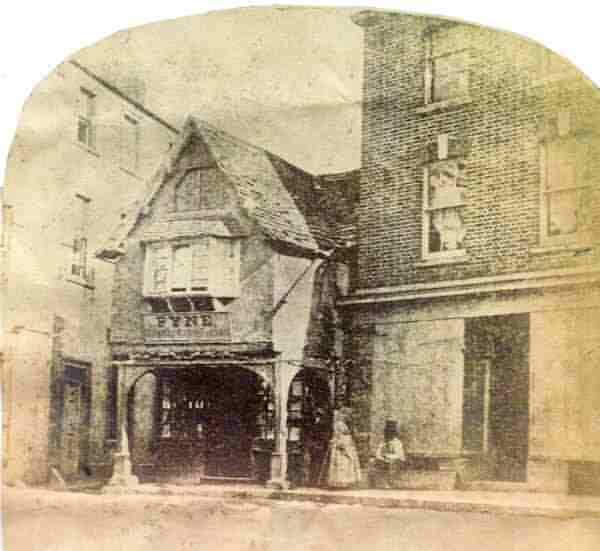
Courtesy of Mrs
M J Rogers
Under Bow, in the Borough on the corner of Grope Lane, photographed in 1861 by artist and photographer Frederick Treble.
At far left is probably the first photograph of the Wine Street elevation of the newly-built Medical Hall, and at the right is an early photograph of the building that was part of Josiah Hannam's ironmongery and, later, William Maynard's Boro' Restaurant.
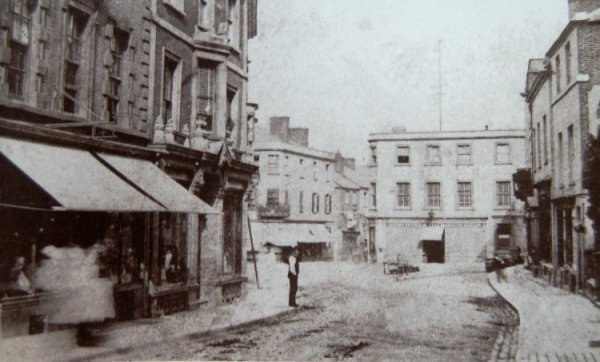
From my
collection. This
photograph
features in my
book "Lost Yeovil"
This early photograph dates to about 1875 and looks towards the Borough from High Street with the end of Middle Street at centre. The newly-built three-storey building to right of centre was Thomas Maggs' pharmacy and dental surgery and, as its predecessor, was named the Medical Hall.

This
colourised photograph
features in my
book 'Yeovil From Old Photographs'.
This photograph was taken by Yeovil Photographer Jarratt Beckett and published in his 1897 book "Somerset viewed through a Camera". At left is London House, at this time being run by George Wadman. At right is the side of the Medical Hall which, at this time was occupied by wholesale and retail chemists Oswald Gatward and Alfred Wright. Next door to the Medical Hall was the International Stores that had earlier been the premises of clockmaker, silversmith and jeweller John White Hancock from the 1820s, then his son James Hancock and finally Hancock, Cox & Co, Clock and Watch Makers until about 1894.
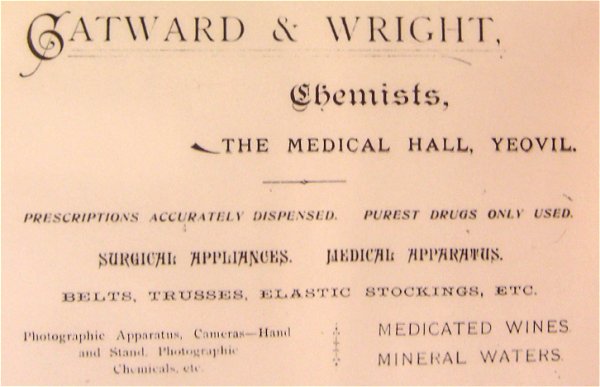
An advertisement from Whitby's Yeovil Almanack Advertiser of 1887. Note the very early date that the company was dealing in photographic equipment and materials.
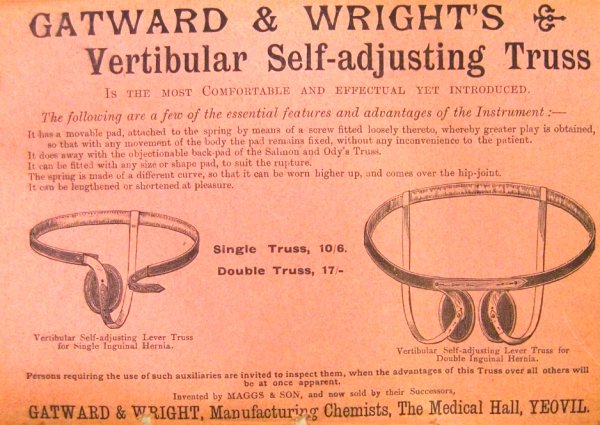
.... and Gatward & Wright didn't just deal in photographic materials! This advertisement is from Whitby's Yeovil Almanack Advertiser of 1900.
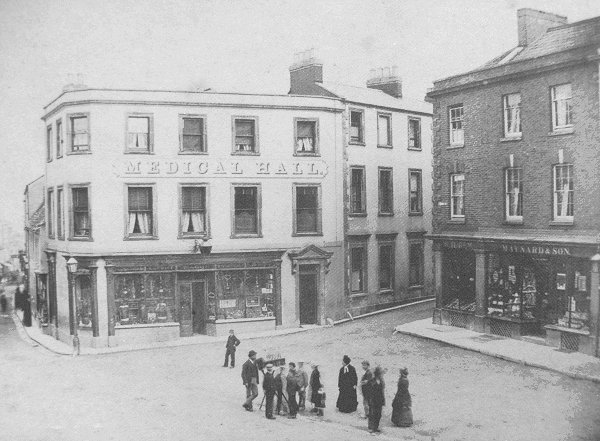
From my
collection. This
photograph
features in my
book "Lost Yeovil"
This photograph was taken in the 1890's and shows the old Medical Hall at left which was bombed in the Second World War. Right of centre is the entrance to Wine Street and at extreme right is William Maynard's shop in the Borough. At this time the Medical Hall was being run by chemists and partners Gatward and Wright.
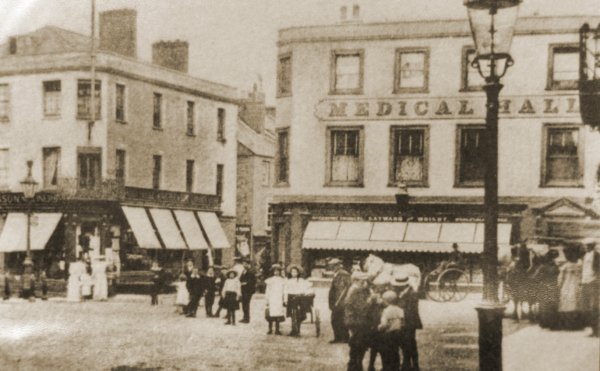
From my
collection. This
photograph
features in my
book "Lost Yeovil"
London House, at left, and the Medical Hall photographed around 1900. Gatward & Wright's name is just visible above the awnings.
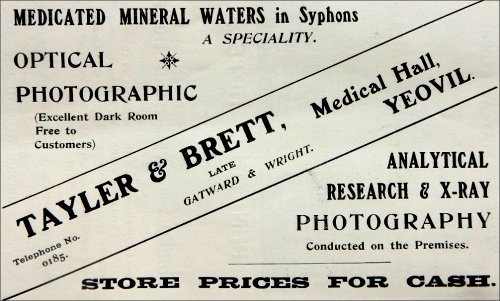
This advertisement dates to 1906 and shows that by this time Tayler & Brett were using the Medical Hall as their premises, specialising in photography.
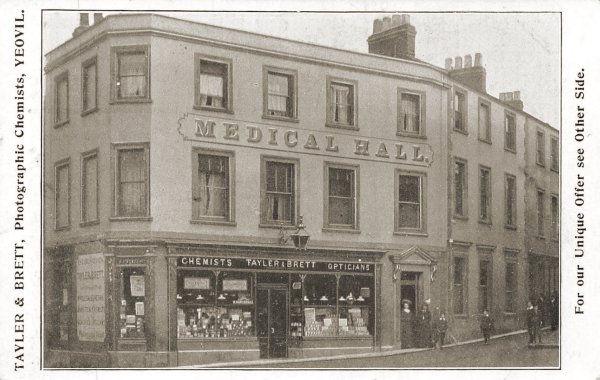
This photograph
features in my
book 'Yeovil
From Old
Photographs'
An advertising postcard featuring the Medical Hall, issued by Tayler & Brett in 1907.

An enlargement of the previous photograph.
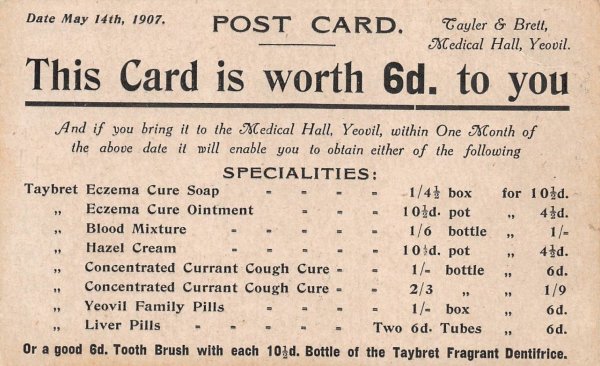
.... and the reverse of the above postcard, I really wonder what 'Yeovil Family Pills' were for?
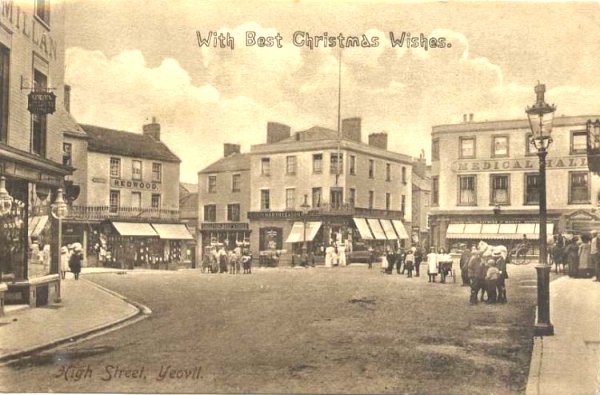
A Christmas postcard of the Borough, dated 1911, with the Medical Hall at right.
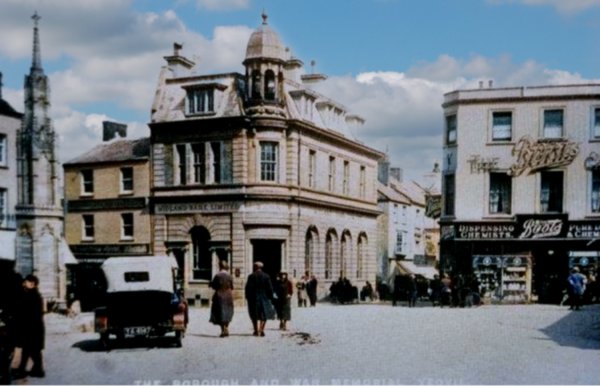
This colourised postcard is dated 1925 and is almost the same view as the 1911 photograph above. The new War Memorial stands to the left and at this time you could drive your car either side of it. At centre the Midland Bank building has replaced London House but the Medical Hall, now Boots the Chemist, remains.
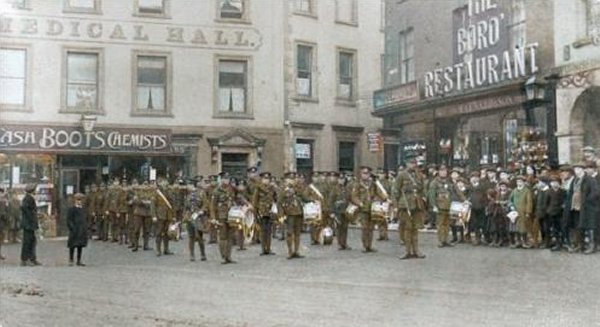
Troops parade in the Borough in a colourised photograph of 1914 (there's always one who has to turn around!). The Medical Hall at left and Maynard's Borough Restaurant at right flanking Wine Street.
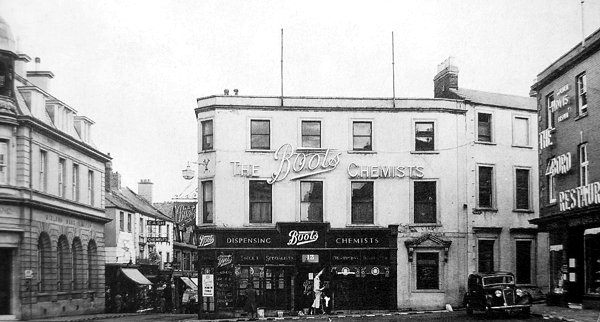
Probably one of the last photographs ever taken of the old Medical Hall around 1939 before it was destroyed by enemy bombing on Good Friday 11 April 1941.
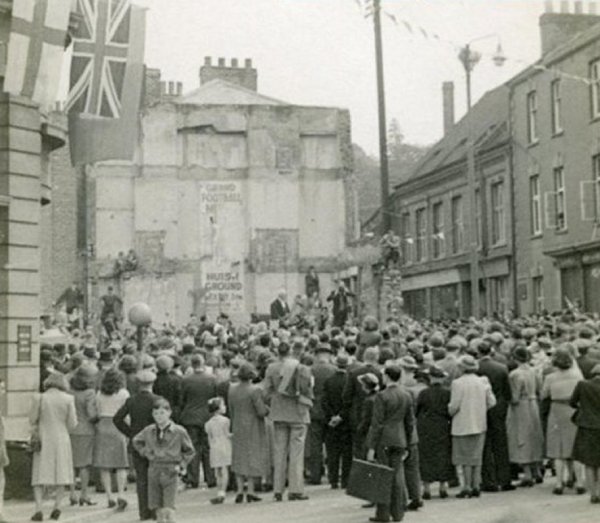
Courtesy of Jack
Sweet
A crowd gathers in the Borough to listen to speeches on VJ-Day, 15 August 1945. The crowd was noticeably smaller than that which celebrated VE Day. This is the site of the bombed Medical Hall and the buildings at right are in Wine Street.
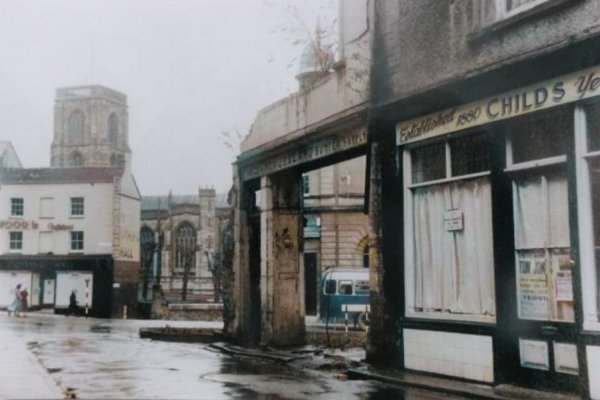
Courtesy of Jack
Sweet
The view (colourised) from Wine Street to the Borough with the ruins of the Medical Hall at the right. This is dated from the poster in Childs' window - 'Tom Jones' was Yeovil Operatic Society's production of 1951.
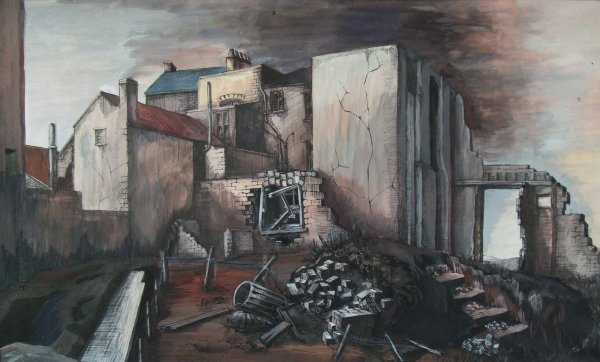
Courtesy of Jean
Mellings née
Spilsbury
While at Yeovil School of Art in 1951, 18-year-old Jean Spilsbury painted this scene of the bombed Medical Hall.
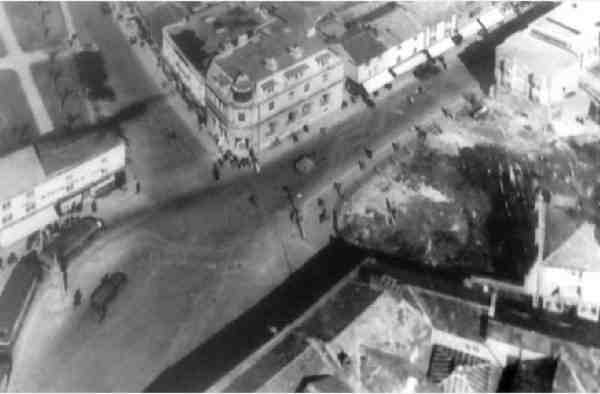
The bombsite that had been the Medical Hall photographed around 1945. The site has only been partially cleared and this was long before the garden was laid out.

After the war, the site that had been the Medical Hall was converted into a temporary garden planted with tulips donated to the town by Dutch children who had been evacuated to Yeovil during the war. It was later landscaped as seen in the following photos.
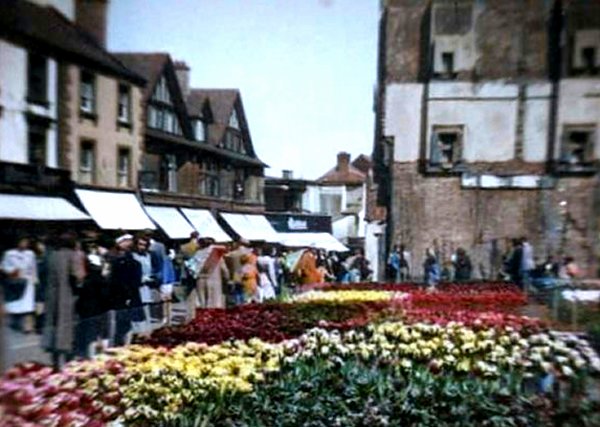
Photo
(colourised) by Leonard
Marshall,
courtesy of
Carol McStravick
The garden seen from the Borough, looking to Middle Street.
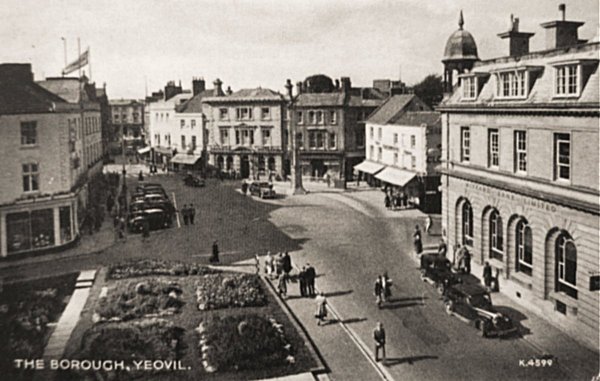
This postcard dates to 1947 and shows an unusual view of the Borough. Wine Street runs off to the left, High Street is at top left and Middle Street runs to the bottom right corner. The gardens at bottom left mark the site of the bombed Medical Hall.
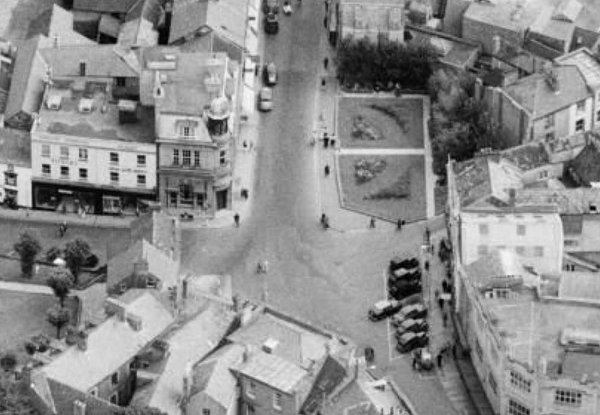
A 1953 aerial photograph of the Borough featuring the garden on the site of the bombed Medical Hall.
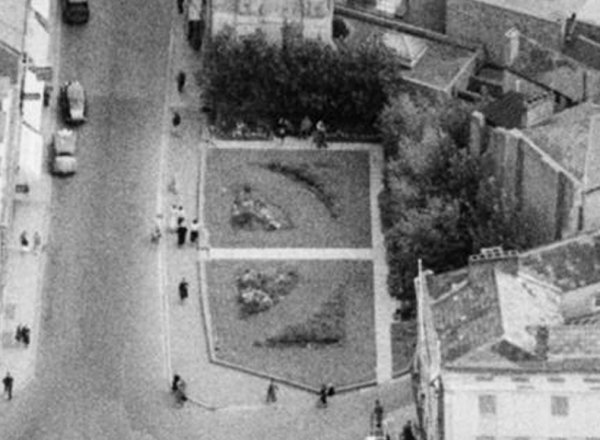
An enlargement of the previous aerial photograph showing the garden in more detail.
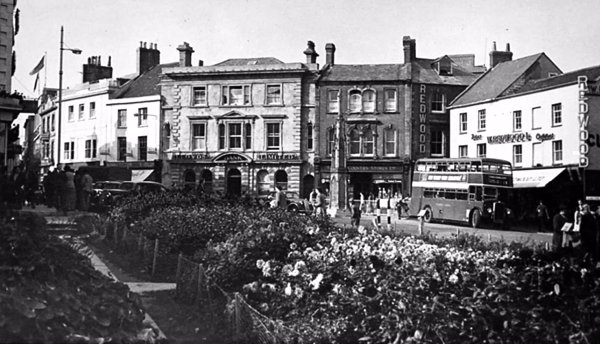
View of the Borough - and a double-decker bus - as seen from the gardens. Photographed in the early 1950s.
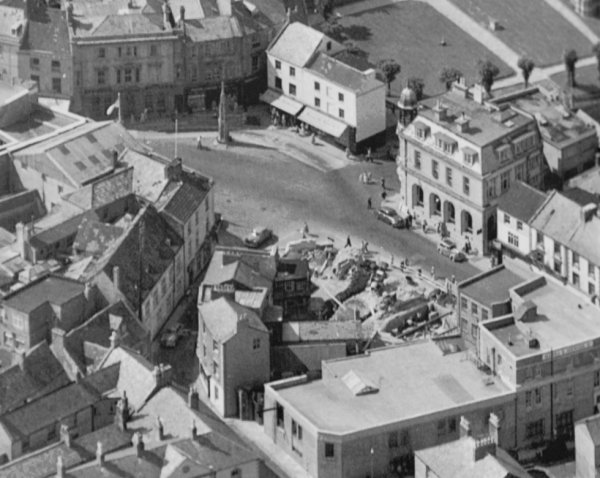
In this aerial photograph of 1955 the garden has been removed and the site is being prepared for the construction of the new Boots building.
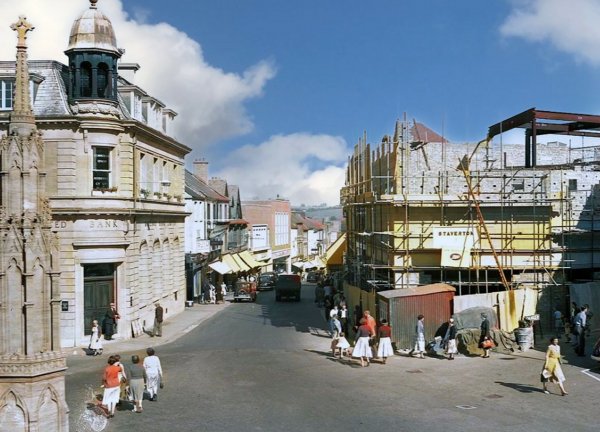
Courtesy of Rob
Baker
The new Boots' building arises on the site of the old Medical Hall in late 1955 / early 1956 in this colourised photograph.
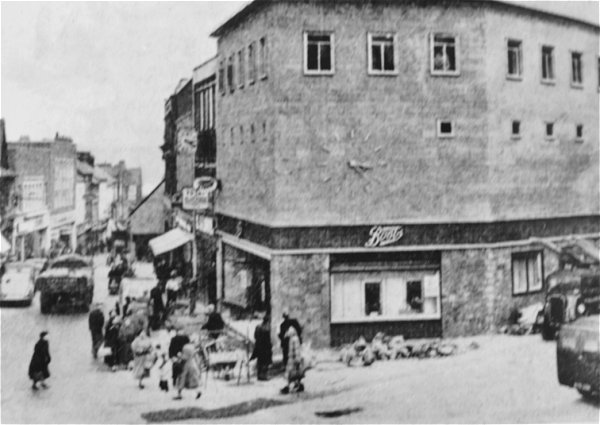
This photograph shows the new Boots building nearing completion in the 1950s.
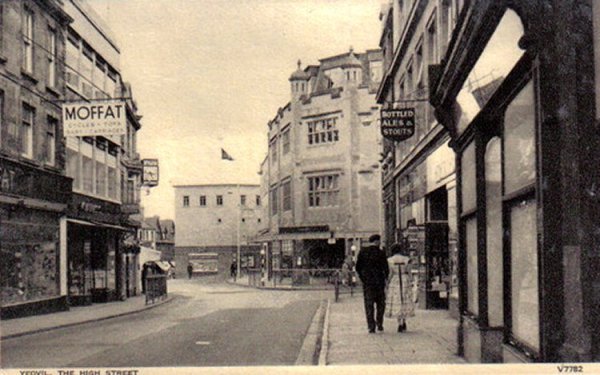
This postcard from the mid-1960's looks along High Street to the Borough and left of centre is the new Boots the Chemist building that replaced the old Medical Hall.
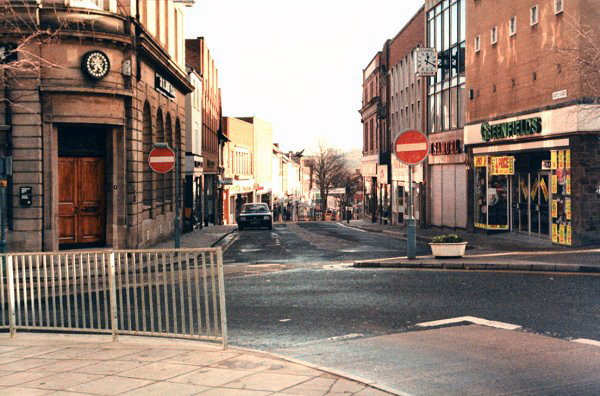
Courtesy of
Chris Rendell
Middle Street seen from the Borough in early 1985. At left the Midland Bank is still there (now HSBC), but who remembers Greenfields? I certainly don't.
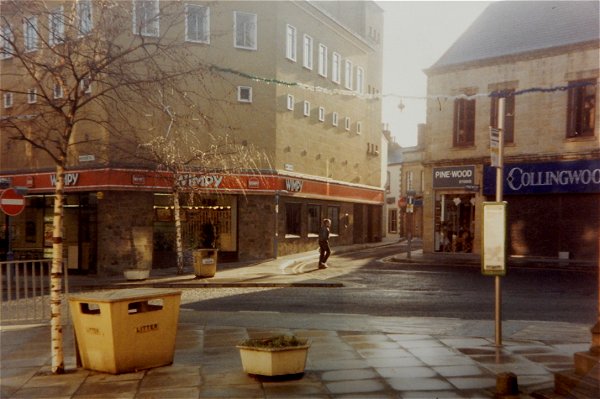
That's more like it, photographed around 1985, Wimpy has taken over the old Boots building but I can't remember what type of shop Collingwood's (at right) was.
The site of the medical hall - Then and Now

From my 2024 book "Yeovil, Then and Now"
Above is a photograph of the mid-1930's, looking across the Borough to Middle Street at the left, Boots the Chemist in the old Medical Hall at the centre, with Wine Street at the right.
The Medical Hall was destroyed by bombing, on Good Friday, 11 April 1941. Boots rebuilt on the site and the present building, below photographed in 2024, dates to 1956. Boots later moved into new premises in Middle Street and, after various occupiers, it is now Burger King.